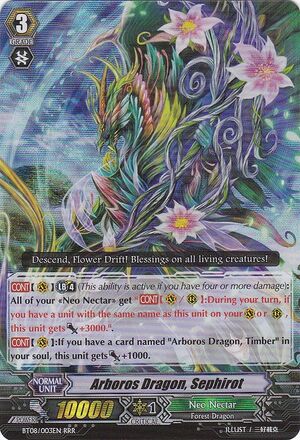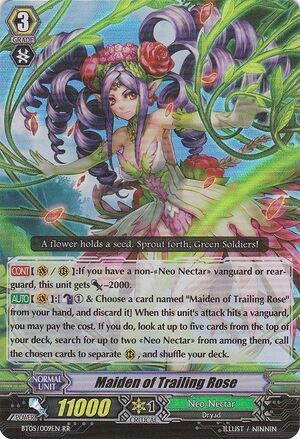Starter: Arboros Dragon, Ratoon
Grade 0:
4x Chestnut Bullet (Critical)
4x Night Queen Musketeer, Daniel (Critical)
4x Dancing Sunflower (Draw)
4x Sweet Honey (Heal)
Grade 1:
4x Arboros Dragon, Branch
4x Maiden of Blossom Rain
4x Corolla Dragon
3x Caramel Popcorn
Grade 2:
4x Arboros Dragon, Timber
4x Glass Beads Dragon
3x Maiden of Rainbow Wood
Grade 3:
4x Arboros Dragon, Sephirot
3x Maiden of Trailing Rose
The focus of this deck is to get as many units with the same name on the field as possible, to make the most use of Sephirot's Limit Break. Riding Branch (the Grade 1) on Ratoon (the Grade 0) has the standard Generation 3 Ride Chain skill of searching the top 7 cards of your deck for Timber (the Grade 2) or Sephirot (the Grade 3). Riding Timber on Branch allows you to select 1 of your Rear Guards and call another copy of it from the deck. Riding Sephirot on Timber applies the same skill. This allows you to turn 1 booster into 3, while simultaneously creating the perfect setup for Sephirot's Limit Break, which reads "[CONT](VC) Limit Break 4: All of your <Neo Nectar> get '[CONT](VC/RC): During your turn, if you have a unit with the same name as this unit on VC or RC, this unit gains 3000 Power.'" Essentially, this means that if you have 2 or more cards of the same name on the field, they all gain 3000 Power.
 The optimist would think "Wow, this skill is amazing, and the ride chain makes it guaranteed to go off!" while the skeptic would think "Wow, you have to keep a bunch of units on the field, and your powerlines all fall apart if any of them get retired." Both of these viewpoints are accurate. Sephirot is capable of consistent, insane powerlines with his Limit Break, but also falls to any retiring-based deck... or does it?
The optimist would think "Wow, this skill is amazing, and the ride chain makes it guaranteed to go off!" while the skeptic would think "Wow, you have to keep a bunch of units on the field, and your powerlines all fall apart if any of them get retired." Both of these viewpoints are accurate. Sephirot is capable of consistent, insane powerlines with his Limit Break, but also falls to any retiring-based deck... or does it?
Upon looking at this deck, one would immediately think that the ideal field would be a backrow of all the same unit (preferably Corolla Dragon, who offers the biggest boost post-Limit Break), as well as two of the same front-row Rear Guards. However, anyone whose played this game for more than a week would know that the front row is a very vulnerable place for units to be, and counting on them for the main strategy of the deck isn't too consistent of a strategy. Because of this, it's best to focus on the boosters, via cloning them with the ride chain or just calling them the good-'ole fashioned way. Regardless, since your boosters will be the most consistent units on your field, they should be your goal to replicate. A backrow of Corolla Dragons turns every Grade 2 in the deck into a 20,000 Power column, assuming the opponent hasn't let you clone the front row as well.
However, what happens if you don't get the Ride Chain? Decks like this tend to fall apart if you can't get your ideal Vanguard, and can't reap the benefits of riding up the correct Grade 1's and 2's. That is the reason Maiden of Trailing Rose is in the deck. Some people might want to opt to run Frontline Valkyrie Laurel because she can make 26000 Rear Guard columns with Corolla, but those people would be bad at the game. That setup is terribly inconsistent for the fact that it requires you to have a backrow full of Corolla's, as well as both front RG slots filled with Laurels. Since her only real use in the deck is an inconsistent field setup, and being forced to ride her if you can't get Sephirot sucks, Laurel is just an overall terrible choice for the deck.
 Maiden, on the other hand, was almost made to be a matching pair. As a backup, she offers the same 11,000 defense as a ride chain-powered Sephirot. In the instance that you miss the chain completely, I find riding Maiden to be a smarter choice than sitting on a 10,000 Power Vanguard, at least until Limit Break becomes active. Additionally, her Persona Blast allows for some very potent mid-game pushes and very good field fixing. Its always nice to know that, if you miss the plusses from the ride chain, you'll still be able to get plusses from HER skill. Beyond that, she has great synergy as a Rear Guard; all of the boosters in the deck should be boosting for 10,000 post-limit break (Caramel Popcorn and Branch will be 10,000 and Corolla Dragon will be 11,000), which will create a 21,000 or 22,000 column with her, respectively. That's a nice number to hit in the RG.
Maiden, on the other hand, was almost made to be a matching pair. As a backup, she offers the same 11,000 defense as a ride chain-powered Sephirot. In the instance that you miss the chain completely, I find riding Maiden to be a smarter choice than sitting on a 10,000 Power Vanguard, at least until Limit Break becomes active. Additionally, her Persona Blast allows for some very potent mid-game pushes and very good field fixing. Its always nice to know that, if you miss the plusses from the ride chain, you'll still be able to get plusses from HER skill. Beyond that, she has great synergy as a Rear Guard; all of the boosters in the deck should be boosting for 10,000 post-limit break (Caramel Popcorn and Branch will be 10,000 and Corolla Dragon will be 11,000), which will create a 21,000 or 22,000 column with her, respectively. That's a nice number to hit in the RG.
But what about the situations where you completely miss the ride chain, and have a field full of almost no clones? Well, Sephirot can STILL work! I'd like to point out that the G3 lineup tends to be the weakest section of any deck; you load it up with your boss G3 in order to maximize the chances of riding it, but since such bosses tend not to be such good RGs, they leave you with 10,000 or 11,000 vanilla RGs. However, the wording of Sephirot's Limit Break is very key here; it gives the skill not only to RGs, but the Vanguard as well, and counts the Vanguard when counting units. That means any Sephirot you call to the RG automatically becomes Palamedes, as well as powering up the Vanguard! A single Sephirot in the rear guard can turn a field of three 2-stage powerlines into one 2-stage and two 3-stage.
The ability to recruit a perfect field with ease, combined with the ability to turn a "terrible" field into a winning one is what makes Sephirot such a powerful and potent deck. This is a game of advantage, and Sephirot is a deck that functions admirably no matter what kind of advantage it may incur. Lackluster units you may earn from raw advantage, such as draw triggers and the Glass Beads/Rainbow Wood cards can be turned into powerful attackers/boosters with his Limit Break. Securing the early quality advantage with the ride chain allows you to focus on gaining raw advantage, because you simply won't need the quality cards like most other decks do. In short: Sephirot is a deck that works.
where did u disappear ? >_<
ReplyDeleteHaha this is a bit late of a reply but, well... exams and summer and whatnot. Plus I didn't have much to write about for a while. But I'm hoping to get some more articles up pretty soon!
ReplyDelete